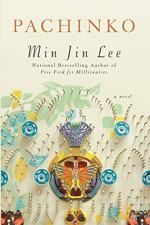|
This section contains 920 words (approx. 3 pages at 400 words per page) |

|
Pachinko Summary & Study Guide Description
Pachinko Summary & Study Guide includes comprehensive information and analysis to help you understand the book. This study guide contains the following sections:
This detailed literature summary also contains Quotes and a Free Quiz on Pachinko by Min Jin Lee.
The following version of this book was used to create this study guide: Lee, Min Jin. Pachinko. Grand Central Publishing, 2017.
The novel covers many decades and crosses many countries to detail the lives of the Baek family. The novel begins in Yeongdo, where the disabled and kindly Hoonie, marries the poor Yangjin. Together, they manage a boardinghouse and have one daughter, Sunja. In Sunja’s youth, Hoonie dies, and Yangjin and Sunja are left to care for the boardinghouse on their own. When Sunja is a teen, she meets the wealthy fishmonger, Koh Hansu, who woos her; the couple begins a sexual relationship. Around the same time, the kindly minister-in-training, Baek Isak, comes to stay at the boardinghouse. Soon after his arrival, Isak falls ill with tuberculosis, and Yangjin and Sunja care for him. Later, Hansu informs Sunja he cannot marry her because he is already married to a woman in Japan. When he is well, Isak tells Sunja he will marry her, raise her child as his own, and take her to Japan.
The couple moves to Osaka, where they stay with Isak’s brother Yoseb and sister-in-law Kyunghee. Isak begins work as a minister. Still, the family struggles with Japanese perceptions of Koreans and their limited opportunities. Eventually, Sunja’s son Noa is born; soon after, Isak and Sunja have a second son, Mozasu. Tragedy later befalls the family, however, when Isak is forced into prison for a trumped-up charge from the Japanese government due to his Christian beliefs. Isak is imprisoned for years and is only released on his deathbed. He comes to see his family one last time before he dies.
After Isak’s death, Kyunghee and Sunja start to sell kimchi at a market to make extra money for the household. Soon after they begin their business, they are asked by a man named Kim Changho to make kimchi at his employer’s restaurant daily, for a hefty salary. Despite Yoseb's hesitation, the women agree. When the war is in full force, Sunja’s former lover, Hansu, comes to tell her that the restaurant was his and that he intended to move her and her family to the countryside to protect them from the war. Sunja goes hesitantly to the farm; Hansu also tracks down Sunja’s mother and delivers her to the countryside.
After the war, Noa expresses his interest in attending college. After finally being accepted to Waseda University, Noa asks the man he perceives as a family friend, Hansu, to pay for his college expenses. Hansu wholeheartedly agrees, refusing Sunja's offer to eventually pay him back. Soon after, Noa goes to Tokyo. At the same time, Mozasu hates school more and more, and after a bout of fighting, secures employment at a local pachinko parlor. Both boys feel they have found their niches. Noa even starts dating a Japanese girl, Akiko, while Mozasu falls in love with a Korean woman named Yumi. Soon, though, Noa’s life in Tokyo is spoiled. Akiko arrives uninvited to a dinner Noa was having with Hansu; afterwards, she tells Noa he did not want her to meet his father because Hansu was a gangster. Noa hurries home to ask his mother if Hansu really was his father. Sunja tells her son the truth.
Distraught by his paternity, Noa leaves school and his family, traveling to Nagano, Japan to begin a new life. There, he assumes a Japanese identity and name, and finds a job at a pachinko parlor. He marries and has children, never visiting his mother but regularly sending her money. During the same period, Mozasu marries Yumi, and they have a son, Solomon. When Solomon is a toddler, Yumi is hit and killed by a taxi. Mozasu and his family relocate to Tokyo, taking Sunja with them to care for the child.
Later, Hansu informs Sunja that he has discovered Noa’s whereabouts. Together, they travel to Nagano, where Sunja meets with her son in his office. Noa promises to reestablish a relationship with his mother, but soon after, Sunja learns her son committed suicide soon after her visit.
When his son is a teenager, Mozasu starts dating a Japanese woman named Etsuko. Etsuko has a daughter named Hana who comes to live with her. At Yangjin’s funeral, Hana and Solomon flirt with one another; the teenagers having sex with one another until Hana leaves her mother’s apartment and disappears. Solomon attends college in the United States, where he meets a Korean-American girlfriend, Phoebe. After graduation, Solomon and Phoebe move back to Tokyo, where Solomon has a job with a British firm, but Phoebe hates living in Japan. Solomon visits Hana is the Tokyo hospital where she is dying of AIDS. After Solomon’s firm asks him to commit a corrupt dealing with an elderly Korean woman, he is fired. Soon after, Phoebe leaves Solomon, and he realizes he wants to remain in Japan and work with his father in his pachinko business.
The novel ends with Sunja visiting Isak’s grave. There, she meets a gravedigger who tells her that Noa continued to visit Isak’s grave after he knew that Isak had not been his biological father, a time when Sunja knew her son was already living in Nagano. After the gravedigger leaves, Sunja buries a keychain she has with a picture of her two sons in Isak’s grave, and then returns to Kyunghee, her dear friend who is waiting at the home they share.
Read more from the Study Guide
|
This section contains 920 words (approx. 3 pages at 400 words per page) |

|



